#Dicentrarchus labrax
Text
Transcriptome profiling of microdissected cortex and medulla unravels functional regionalization in the european sea bass Dicentrarchus labrax thymus
Pubmed: http://dlvr.it/T0k7pL
0 notes
Text
Branzino, Funghi E Cerfoglio
Branzino, Funghi E Cerfoglio
Branzino Funghi E Cerfoglio è un secondo piatto di pesce classico, per assaporare tutto il sapore del mare nella sua interezza. Senza aggiunta di troppi ingredienti, solo delle verdurine e funghi per esaltare ancora di più il gusto del branzino
Branzino Funghi E Cerfoglio
Il branzino (Dicentrarchus labrax L.) anche conosciuto come spigola, è un pesce appartenente alla famiglia dei Moronidae e…

View On WordPress
1 note
·
View note
Text
Microplastics also in fish from fish farms in the Canary Islands
Microplastics also in fish from fish farms in the Canary Islands
Magazine polymers has recently edited an article that shows the presence of microplastics in the gastrointestinal tract of specimens of sea bream (Sparus aurata) and sea bass (Dicentrarchus labrax) from marine aquaculture farms on the island of Tenerife.
The work carried out by the Applied Analytical Chemistry research group (AChem) of the University of La Laguna, coordinated by the tenured…

View On WordPress
0 notes
Link
https://www.intotheblue.it/2019/12/14/the-hunting-of-seabass-dicentrarchus-labrax/
0 notes
Text
Spigole autunnali all’inglese
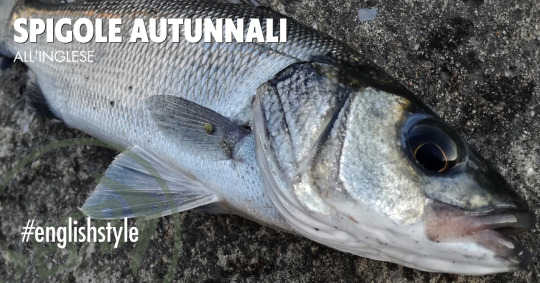
La pesca alla spigola all’inglese nel tratto di foce. Spot, maree, montature e considerazioni generali.
In un articolo precedente abbiamo introdotto le basi per la pesca all’inglese in corrente. In questa sede prendiamo in considerazione la stessa tecnica ma con un lenza un po’ diversa, non perché le precedenti non siano valide ma per il fatto che di approcci ve ne sono un’infinità (relativa) e pian piano è utile osservali tutti (o comunque quelli principali).
Lo spot è ancora il tratto cittadino dell’Arno Pisano, luogo ideale per delle sessioni di street fishing con la pesca al colpo come protagonista.
In autunno, prima della stagione delle piogge che ingrossano il fiume e generano correnti più marcate, la pesca all’inglese trova qui le condizioni ideali per la sua applicazione e l’assenza di vento ci consente di mettere in campo lenze leggermente più elaborate, come sono ad esempio le spallinate a scalare.

Le ore migliori per insidiare gli amati moronidi, neanche a parlarne, sono quelle a cavallo dell’alba e del tramonto, possibilmente durante la fase di marea crescente. Esca principe è il bigattino. Ottimi risultati si ottengono anche con il verme francese ma l’approccio è molto diverso dato il peso dell’esca e la generale assenza di pasturazione quindi ci riserviamo di parlarne più avanti.
Lo spot
Vi sono alcune considerazioni da fare. La giusta distanza di pesca in questo tratto di foce è entro una ventina di metri circa da riva o, per utilizzare una misura pratica, entro le “quattro canne” (prendendo come riferimento la match rod che utilizzeremo). In questo periodo di inizio autunno la corrente del fiume è molto lenta e risente in maniera notevole del flusso di marea tanto che nella fase di massima spinta (in salita) il galleggiante procede a velocità molto bassa verso valle e subito sotto riva addirittura inverte la sua corsa potendo a tratti dirigersi a monte.
Non è peraltro raro trovarsi in momenti in cui l’acqua risulti apparentemente ferma o che vi sia una doppia corrente, con gli strati superficiali dell’acqua che scendono a foce e quelli più profondi che sotto la spinta della marea invece risalgono.
Setup generale della lenza
In queste condizioni le lenze sono ancora molto semplici, com’è nello spirito della pesca all’inglese, ma un numero di pallini leggermente superiore permette variazioni di distribuzione che aumentano la capacità di adattamento alle variabili correnti che possiamo incontrare. A questo proposito consiglio di stringere delicatamente i pallini (comunque di tipo morbido), in modo da poterli spostare e adattare così la montatura prontamente e senza particolare stress per il filo.
La profondità, nella zona di pesca è indicativamente sui 2.5-3 mt. Non si può pescare appoggiati sul fondo in quanto è assai irregolare, pieno di ostacoli e formazioni calcaree. Occorre stare quindi sollevati quel tanto che basta per evitare incagli.

La lenza madre come sempre è dello 0.18 in filo affondante o fluorocoated. La spallinata viene invece realizzata su uno spezzone dello 0.16 che può essere collegato alla lenza madre tramite un nodo di sangue o una microgirella. Benché io preferisca il nylon, per il terminale in casi come questo conviene valutare l’uso di un fluorine oppure di un fluorocarbon morbido: il fondale nel tratto di fiume preso in considerazione è ad alto rischio di abrasione (fondo a pietre non di rado cosparse di tubi calcarei).
La misura media per il finale è lo 0.12 potendo però salire allo 0.14 o scendere anche allo 0.10. Dipende dal livello di torbidità dell’acqua, dalla corrente, dalla taglia dei pesci (che comunque qui si attesta generalmente sotto il chilo e mezzo), ecc.
I galleggianti sono i classici straight wagglers da acque lente o comunque di corrente moderata. Si utilizzano quelli già piombati e dotati di porta starlight.

Relativamente alla distribuzione dei pallini si opta per una spallinata aperta del tipo 3x3 (tre pallini del numero 8, tre del 7 e tre del 6). Si pone il primo pallino del numero 8 subito sopra la giunzione con il finale e poi si scala di due centimetri alla volta (quindi secondo pallino a 20 cm dal primo, terzo pallino a 18 cm dal secondo e così via fino all’ultimo pallino per una lunghezza globale di più o meno un metro). Il peso totale della distribuzione è, a seconda della marca dei pallini, di circa 0.8 gr, così possiamo utilizzare uno straight waggler come un classico 3 o 4+1. Riservatevi ovviamente di aggiungere qualche pallino di taratura se necessario.
Le distanze tra i pallini sono indicative, non prendetele come un vangelo.
Questa è una classica lenza a scalare in distanza e peso che deve essere modificata al variare della corrente.
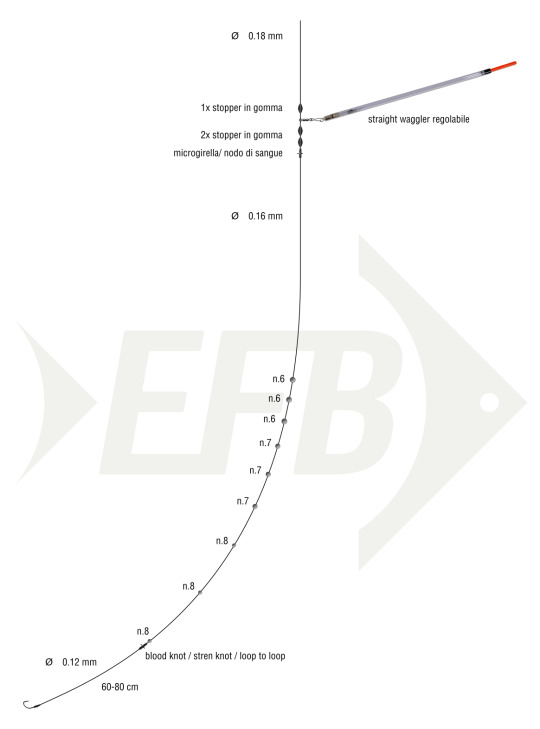
Nove (o più) pallini possono essere distribuiti in tanti modi diversi quindi non abbiate il timore di sperimentare. A seconda delle necessità la lenza si può aprire ulteriormente, si può accorciare, si può invertire (chiudere verso il basso), ecc. Ovviamente il consiglio è di non operare cambiamenti a casaccio ma secondo una logica dettata dalle condizioni del momento che sono sia fisiche (marea, correnti) quanto legate all'abitudine momentanea delle prede (pesci che preferiscono talora mangiare più in prossimità del fondo, talora più a mezz’acqua).
Azione di pesca
L’azione di pesca è quella classica. Lo scopo è ovviamente quello di presentare l’esca “in pastura” che questa cali lentamente verso il fondo in modo abbastanza verticale (acque lentissime, quasi ferme) oppure scenda in diagonale (presenza di corrente). Nel primo caso pescheremo più o meno in un punto abbastanza preciso, nel secondo opereremo una passata.
Intuire la corretta discesa delle larve (tempo e direzione) è fondamentale e la lenza dovrà assicurare la massima naturalezza della presentazione. Occorre fare attenzione ad una possibile doppia corrente che dopo un percorso diagonale verso valle (strati più superficiali dell’acqua) potrebbe spingere le larve indietro (strati più profondi). Questo può verificarsi in maniera incostante in certi momenti (e in certi punti) durante la salita della marea.

Nonostante le maree vengano rappresentate per approssimazione con una curva continua di tipo simil-sinusoidale, le variazioni dei livelli idrometrici avvengono in realtà a “zig-zag”. Infatti osservando l’acqua entro i primi metri da riva si può notare come in una stessa fase di marea vi siano momenti in cui la corrente può mutare anche con un certa evidenza. Osservare questo comportamento, qualora si verifichi, può essere di aiuto e può spiegare perché talvolta il punto in cui si registra il maggior numero di mangiate possa variare.
Quanto alla pasturazione questa non deve essere mai esagerata e vale la regola d’oro delle piccole quantità a ritmo costante. Particolare attenzione va fatta circa il rapporto tra punto di ingresso in acqua delle larve sfuse e collocazione della lenza ricercando, come detto prima, la massima corrispondenza tra la discesa dei bigattini e il movimento dell’esca.
Un po’ di esperienza, un goccio di intuito e una manciata di “trial and error” sono gli ingredienti base della ricetta. Il resto è variabile e non sempre, e necessariamente, nelle mani del pescatore.

Testo e foto: Franco Checchi
2017. Articolo aggiornato il 4 marzo 2020
0 notes
Text
Scientific Illustration

Until recently we had no real clue regarding scientific illustrations. But that all changed when we came across this one depicting a bass.
Dicentrarchus labrax is present in society in a lot of different ways. Even in the crossover between science and arts, as the print above clearly demonstrates. It’s a so-called scientific illustration. In this field art and science come together, recording and communicating the wonders of nature. The use of illustration allows for a focus on details that convey the essential attributes of a subject with accuracy and aesthetics. In biomedical sciences traditionally illustrations are used to enable communication between scientist and author, teacher and student, or physician and patient. Unfortunately we couldn’t track the history and specific background details of this particular bass print, but Karin Spijker did a real good job on this one.
85 notes
·
View notes
Text
Last summer there was an explosion of Sea-Bass (Dicentrarchus labrax) around the whole island.
This fish is consumed a lot and raised commercially in Europe. 🐟🐟🐟

#scuba#diving#fish#spain#lanzarote#eurodiverslanzarote#eurodiversworldwide#divingwithfriends#seabass
8 notes
·
View notes
Text
Havsabborre - yrkesfiske och odling
Havsabborre – yrkesfiske och odling
Havsabborre (Dicentrarchus labrax) eller på engelska european bass (seabass) förekommer lokalt längs den svenska västkusten, framför allt i Bohuslän. Som vissa andra sydliga arter påträffas den ibland där varmvatten släpps ut, t.ex. vid Ringhals (Bua, Halland). Arten har påträffats även i Öresund och i Östersjön så långt norrut som vid Aspöja i Östergötlands skärgård. Därutöver finns havsabborre…
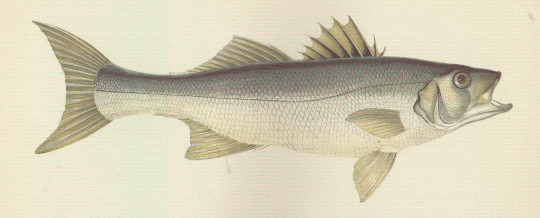
View On WordPress
1 note
·
View note
Photo

Dicentrarchus labrax
Gills, c.I.
optic miscroscope
0 notes
Text
Piscifactorías del Atlántico
MERCREDI 27 MARS
Dans la quête de découverte d’activités maritimes à Lanzarote, la classe de BTS s’est rendue à l’aide d’un navire gouvernemental jusqu’aux “Piscifactorias Del Atlantico”, au départ de Puerto Del Carmen, jusqu’au large de Playa Quemada. C’est à cet endroit que se trouvent les cages à poisson de la firme canarienne “Yaizatún”. Entre ces filets, il est possible d’y observer deux espèces halieutiques : le Bar Commun (Dicentrarchus Labrax) et la Dorade Royale (Sparus Aurata).
WEDNESDAY, MARCH 27
In the quest for discovering maritime activities in Lanzarote, the class went with a government vessel to the "Piscifactorias Del Atlantico", from Puerto Del Carmen, to Playa Quemada. This is where the fish cages of the Canarian firm are located. Among these nets, it is possible to observe two fish species: the Common Bass (Dicentrarchus Labrax) and the Royal Sea Bream (Sparus Aurata).
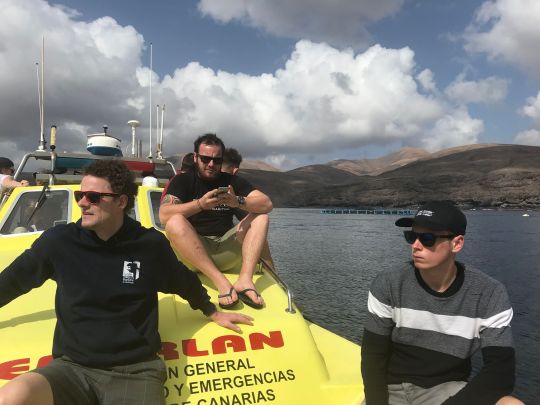
Après une dizaine de minutes de route cap au sud sur le semi rigide, nous voilà dans le parc aquacole aux abords des cages. Le capitaine du canot sur lequel nous sommes est en contact VHF avec le personnel du parc. Ces derniers lui indiquent que nous pouvons aborder l’une des cages pour y observer de plus près les poissons élevés.
After about ten minutes of road heading south on the semi rigid, here we are in the aquaculture park near the cages. The captain of the boat on which we are is in VHF contact with the park staff. They tell him that we can approach one of the cages to look more closely at the raised fish.
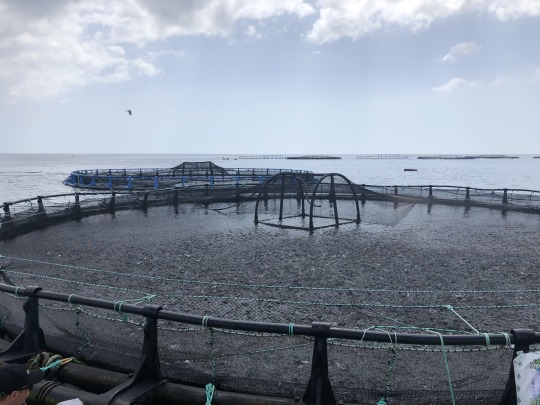
Nous arrivons à point nommé car c’est l’heure du repas pour les poissons, ils sont tous très agités et sont visibles à la surface. Les poissons sont répartis dans les cages selon leur âge. Ainsi il est plus simple de gérer les quantités de nourriture à distribuer. Les plus jeunes sont nourris à la main, à la volée, tandis que les plus âgés sont nourris par des tubes d’alimentation sous pression, car leur besoin en nourriture est plus conséquent. On dénombre approximativement 35 000 poissons par cage.
We arrive at the right time because it is lunch time for the fish, they are all very agitated and are visible on the surface. The fish are distributed in the cages according to their age. Thus it is easier to manage the quantities of food to distribute. The youngest are fed by hand, on the fly, while the older ones are fed by pressure tubes because their need for food is greater.
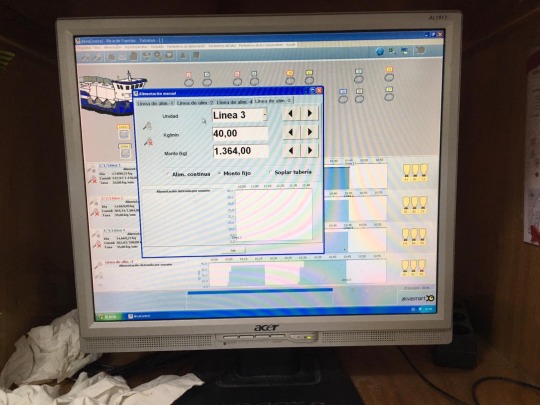
Sur l’écran il est possible de contrôler le débit de croquettes distribuées. Par exemple, à ce moment de la distribution, nous sommes à 40 kilos par minute.
On the screen it is possible to control the flow of distributed kibble. For example, at this point in the distribution, we are at 40 kilos per minute.

Les poissons sont élevés jusqu’à ce qu’ils atteignent le poids minimum de 400g avant d’être revendus.
La firme inclut une perte d’environ 5% sur la totalité de la cage à la fin du cycle. Plusieurs causes sont à déplorer : perte avant l’arrivée aux cages, maladie, cannibalisme, ou encore des évasions de la cage.
Il faut environ 12 à 18 mois pour obtenir un poisson de taille (400g). Ces poissons ont ensuite plusieurs destinations. Ils sont soit achetés par des mareyeurs, des grossistes, des poissonniers, ou exportés vers la péninsule ibérique. Ils sont principalement vendus à la grande marque de supermarchés “Mercadona”.
The fish are bred until they reach the minimum weight of 400g before being resold.
The firm includes a loss of about 5% on the entire cage at the end of the cycle. Several causes are to be deplored: loss before arrival, disease, cannibalism, or escapes from the cage. It takes about 12 to 18 months to get a serving size fish (400g).
These fish then have several destinations. They are either bought by wholesalers, fishmongers, or exported to the Iberian Peninsula. They are mostly sold to the supermarkets “Mercadona”.
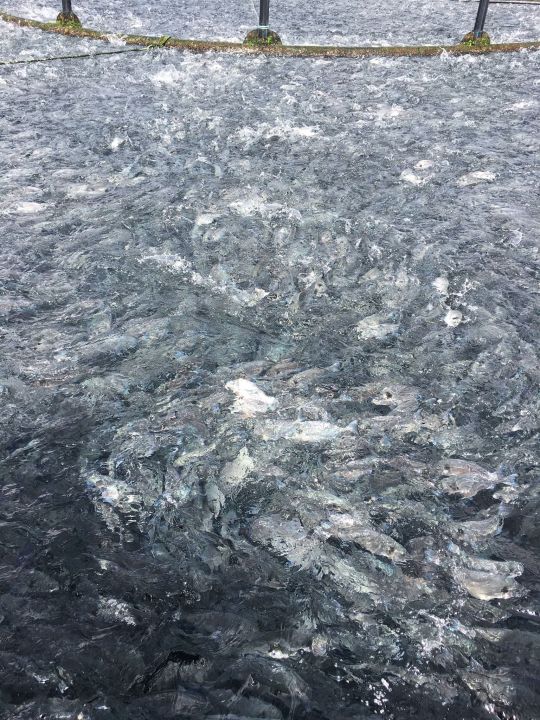
1 note
·
View note
Text

MERCREDI 3 MARS 2022 à 21h chez EURYDICE PARIS
Chers créateurs
Nous serons chez Eurydice pour écouter les poésies de Martin Wable mais aussi les haïkus de Florence Issac et pour admirer les aquarelles de Catherine Morisseau
Et tous ceux qui veulent se joindre à nous pour une scène ouverte musicale et poétique
Bienvenus
https://www.facebook.com/308099659220597/posts/5217852811578566/
79 rue du Cardinal Lemoine 75005 Paris 21h
Tripot Littéraire & Artistique, Cabaret, Estaminet, Dicentrarchus labrax, Cambuse, Lupanar, fondé le mercredi 2e aoust 1589, à deux heures après minuict
https://leurydice.fr/
Tenez moi informée de votre présence
0 notes
Photo

Malta, island country located in the central Mediterranean Sea. A small but strategically important group of islands, the archipelago has through its long and turbulent history played a vital role in the struggles of a succession of powers for domination of the Mediterranean and in the interplay between emerging Europe and the older cultures of Africa and the Middle East. As a result, Maltese society has been molded by centuries of foreign rule by various powers, including the Phoenicians, Romans, Greeks, Arabs, Normans, Sicilians, Swabians, Aragonese, Hospitallers, French, and British.
Until the mid-1960s the Maltese economy depended heavily on the British military presence in Malta. In the 1950s Britain began to withdraw its armed forces, which necessitated a drastic diversification of the economy. A series of development plans after 1959 were supported by government grants, loans, and other fiscal incentives to encourage private investment. Import and capital controls, which were extensive until the second half of the 1980s, were progressively dismantled during the 1990s, moving Malta toward a more market-driven economy as the Maltese government pursued a policy of gradual privatization beginning in 1999. Capital controls were fully lifted only when Malta was acceded to the European Union (EU) in 2004. The Maltese economy faces major constraints because of its small domestic market, and it depends on other countries for many imported goods.
Agricultural development is hampered by land fragmentation (that is, plots of land resulting from decollectivization that are too small or too irregularly configured to be farmed efficiently), shallow soils, and lack of adequate water supplies. Most farming is carried out on small terraced strips of land that preclude the introduction of large-scale mechanization. As a result of the growth of urbanization, the agricultural labour force has become increasingly older, and more farming is done on a part-time basis; nevertheless, production has risen gradually because of improved techniques in the cultivation of some crops, especially horticultural ones. The major crops are potatoes, tomatoes, and fruit (especially citrus and drupes). Since the late 1990s there has been a substantial increase in grapevine and olive production. Malta is generally self-sufficient in food production, but beef is mostly imported. Upon the country’s accession into the EU, Malta’s agricultural sector became competitive.
Fishing is seasonal and, to a large extent, undertaken on an artisanal basis. The common dolphin fish (Coryphaena hippuras) and the bluefin tuna (Thunnus), however, are caught for export. Aquaculture, introduced in Malta in the late 1980s, has surpassed fishing as a source of income. The European sea bass (Dicentrarchus labrax) and the gilthead sea bream (Sparus aurata) are grown in floating sea cages, and the bluefin tuna from the sea are fattened on farms for four to six months before export. After Malta joined the EU, Maltese fishermen benefited from funding programs, particularly to promote the export of tuna.
Malta is poorly endowed with natural resources, and its only exploited mineral resource is limestone, which is quarried and used for construction. Offshore oil exploration has been under way since the mid-1990s, but no significant oil reserves have been discovered. Fossils fuels are imported and supply all of Malta’s energy. There are thermal power stations on both Malta and Gozo.
Industrial development began in earnest in the second half of the 1960s, and by the early 21st century the manufacturing sector was contributing about one-fifth of gross domestic product (GDP). Since the 1980s the manufacture of computer parts, instruments, and electronics, as well as of a large variety of consumer products (toys, cosmetics, detergents, and foodstuffs), has been important. In the early 2000s, light manufacturing (pharmaceuticals, semiconductors, and automotive and airplane parts, along with software) replaced much of the low-cost labour-intensive production that had earlier played a more important role in Maltese manufacturing. Pharmaceutical production in particular has grown rapidly as a result of the patent law advantages that Malta gained upon EU membership.
Shipbuilding and repair have been the foundation of Malta’s economy since the Knights of Malta (Hospitallers) transferred Malta’s administrative centre from the medieval inland location of Mdina to present-day Valletta in the Grand Harbour area in 1570. Since the mid-20th century, however, the shipbuilding industry has consistently operated at a loss and had been dependent upon government subsidies. Efforts aimed at engendering financial sustainability during the late 20th century were not successful. Upon EU accession, such subsidies were no longer permissible, and the Maltese government has taken steps to reduce and privatize the industry.
Malta imports machinery and transport equipment, chemical products, and mineral fuels. The country’s main export products are semiconductors, but it also exports other manufactured goods and refined petroleum. Italy, the U.S., Germany, France, the U.K., and Singapore are Malta’s major trading partners.
Services account for about half of Malta’s GDP and employ about three-fifths of the labour force. Tourism is a major source of income and follows a seasonal pattern, with June through October being the peak season. Some notable tourist sites include the ancient megalithic temple Ġgantija on Gozo and the temples of Ħaġar Qim, Mnajdra, and Tarxien on Malta; this group of temples was designated a UNESCO World Heritage site in 1980. Also on Malta are spectacular medieval castles and cathedrals, as well as the ancient inland capital of Mdina. Tourism has had a major impact on the natural environment of the Maltese islands, and the government has attempted to promote ecotourism.
The majority of Malta’s workforce is employed in the manufacturing and services sectors. Women make up about one-third of the workforce. The public sector is to a very large extent unionized. In the private sector, most large enterprises are unionized. Malta has two chief labour unions—the General Workers’ Union, Malta’s largest union, and the Union of United Workers—as well as a confederation of smaller sectoral unions, each of which came into being around the mid-20th century. Although unions are independent of political parties, they have tended to occupy a central role in national issues and at times have operated on the basis of the party affiliations of their members.
The bulk of government tax revenue comes from a progressive income tax system. There is a value-added tax on consumer goods and services. Taxes on real-estate transactions also contribute to government revenue.
The island of Malta’s road system connects all towns and villages and includes a coast road and a panoramic road. Bus services radiating from Valletta provide inexpensive and frequent internal transportation. Taxis and rented vehicles are available on the island. Most families own automobiles, and the number of cars per household is one of the highest in Europe. There is no railway. Ferry services operate between Malta and Gozo, and Malta and Sicily are connected by both ferry and high-speed catamaran. The national airline, Air Malta, connects Malta with most European capitals as well as with North Africa, the Middle East, and North America. Since 2007 a number of low-cost airlines have offered services to and from Malta.
Malta’s telecommunications sector was fully liberalized in 2004, after Malta joined the EU. The mobile phone penetration rate increased substantially in the early 21st century; the majority of the inhabitants now use cellular telephones, while the number of fixed-line phone lines has remained relatively static. Internet usage increased as well. The Malta Communications Authority, established in 2001, is the regulatory body of the telecommunications sector.
Finally, I will leave a link which includes all companies and enterprises in Malta, for those who want to research and discover more about this country. Thanks for reading.
All businesses address in Malta: https://findsun.net/MT
0 notes
Text
A ULL study detects microplastics in sea bass and sea bream from aquaculture in Tenerife
A ULL study detects microplastics in sea bass and sea bream from aquaculture in Tenerife
SANTA CRUZ DE TENERIFE, 17 May. (EUROPE PRESS) –
The magazine ‘Polymers’ has published an article that shows the presence of microplastics in the gastrointestinal tract of specimens of sea bream (Sparus aurata) and sea bass (Dicentrarchus labrax) from marine aquaculture farms on the island of Tenerife.
The work carried out by the Applied Analytical Chemistry research group (AChem) of the…

View On WordPress
0 notes
Link
http://www.intotheblue.it/2018/07/12/branzino-dicentrarchus-labrax/
0 notes
Text
FISHING ON THE MOON? FRENCH SCIENTISTS THINK THE IDEA IS SWIMMING WITH POSSIBILITIES
The question of how Humankind will feed itself once a permanent colony is established on the Moonis one that is still being discussed and debated. Self-sufficiency, or at least a reasonable facsimile, is of the utmost importance as we venture off Earth and begin exploring not only our own satellite, but exoplanets, asteroids, and moons outside the comforts of our own solar system. According to the research paper first published in the online journal, Springer, samples of fish eggs were put to the test to see if they could endure simulations of a rocket ride aboard a Russian Soyuz spacecraft.
IFREMER scientists were pleased to discover that the eggs of two fish species, European sea bass (Dicentrarchus labrax) and meagre (Argyrosomus regius), were indeed hardy enough and could easily survive being taken to the Moon. สล็อต เครดิตฟรี ไม่ต้องแชร์
0 notes